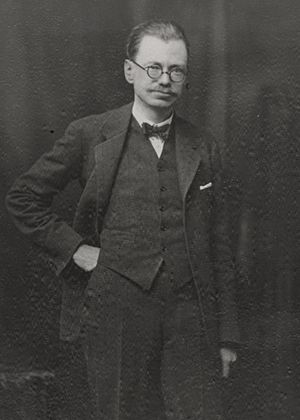Vere Gordon Childe facts for kids
Vere Gordon Childe (usually known as Gordon Childe) was an important Australian archaeologist. He was born in Sydney, New South Wales, on April 14, 1892, and passed away in Mount Victoria, New South Wales, on October 19, 1957. Childe became famous for digging up the amazing Neolithic site of Skara Brae in Orkney, Scotland. He also created two very important ideas: the 'Neolithic Revolution' and the 'Urban Revolution'. He tried to understand how human societies developed across Europe and the world by looking at his discoveries.
Contents
Who Was Gordon Childe?
Gordon Childe was a brilliant thinker who studied ancient human history. He wanted to connect the things archaeologists found in the ground with bigger ideas about how societies changed over time. He believed that human history wasn't just a series of random events. Instead, he thought there were big shifts that changed how people lived.
Early Life and Education
Childe grew up in Australia and went to university there. He then moved to England to continue his studies at the University of Oxford. He was very interested in politics and how societies were organized, which influenced his later work in archaeology.
The Neolithic Revolution
One of Childe's most famous ideas is the 'Neolithic Revolution'. This term describes a huge change in human history. Before this time, people were mostly hunter-gatherers, meaning they moved around to find food. The Neolithic Revolution was when people started to:
- Farm crops
- Keep animals (like sheep and cows)
- Live in permanent villages
This change happened around 10,000 years ago in some parts of the world. It meant people could produce their own food, leading to bigger populations and new ways of life. Childe saw this as a major step forward for humanity.
The Urban Revolution
Another big idea from Childe was the 'Urban Revolution'. This happened much later than the Neolithic Revolution. It describes the time when the first cities began to appear. Before cities, most people lived in small villages. The Urban Revolution involved:
- People living in very large settlements (cities)
- New jobs appearing, like craftspeople, priests, and soldiers
- The invention of writing and complex governments
- Large-scale building projects
Childe believed these two "revolutions" were key moments that shaped human civilization.
Excavations and Discoveries
Gordon Childe was not just a theorist; he was also an active archaeologist who dug at important sites. His most famous excavation was at Skara Brae in Orkney, Scotland.
Skara Brae
Skara Brae is an incredibly well-preserved Neolithic village. It was built around 5,000 years ago. Childe's work there helped us understand what life was like for people in the Stone Age. The houses at Skara Brae are made of stone and even have stone furniture inside! It's like a time capsule showing us how ancient people lived.
Maeshowe
Childe also worked at Maeshowe, another important Neolithic site in Orkney. Maeshowe is a large, ancient tomb. It's famous for how sunlight shines directly into its passage during the winter solstice. Childe's studies here helped us learn more about the beliefs and building skills of Neolithic people.
Legacy
Gordon Childe's ideas about the Neolithic and Urban Revolutions changed how archaeologists and historians think about the past. He helped us see human history as a series of big transformations, not just small changes. His work continues to influence how we understand the development of societies around the world.
Images for kids
-
Neolithic homes at Skara Brae in Orkney, a site Childe excavated from 1927 to 1930.
-
The Neolithic passage tomb of Maes Howe on Mainland, Orkney, which Childe excavated from 1954 to 1955.
See also
 In Spanish: Vere Gordon Childe para niños
In Spanish: Vere Gordon Childe para niños






